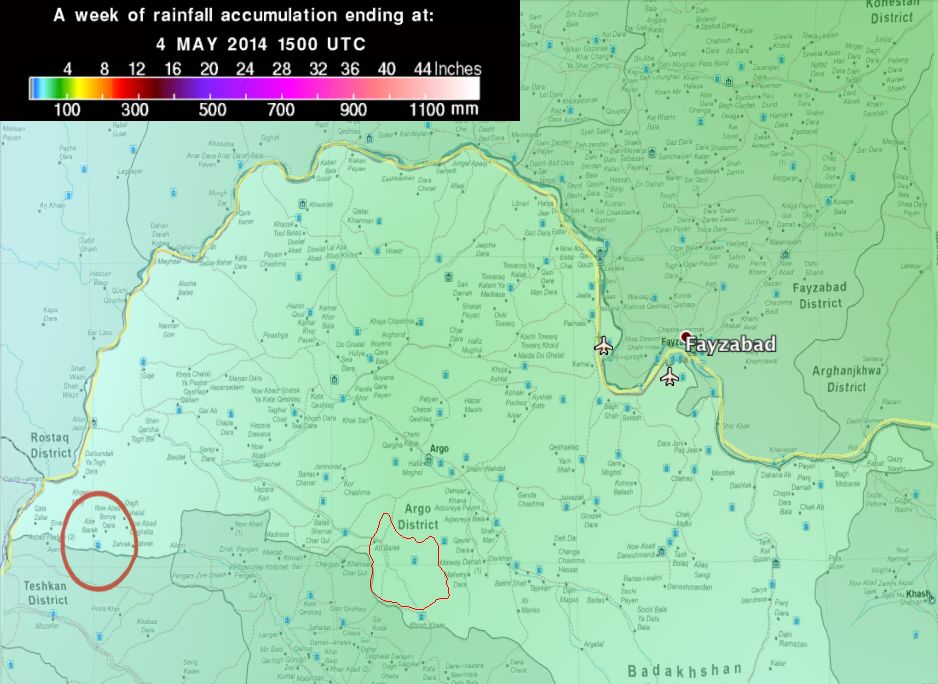A recent rainfall-triggered landslide in Ab Barek (sometimes referred to as Abe Bareek) in the Badakhshan Province of Afghanistan is suspected of taking the lives of up to 2100 villagers. As with so many remote events, details are scarce, although a number of images and videos have appeared on social media websites over the last days. Some images, as that below, indicate the landslide may have crossed a river valley and formed a landslide dam blocking the river running through the town. In a region that has recently experienced heavy rainfall, the formation, and breach of such a dam could have severe consequences to any communities downstream.
Possible landslide dam formation in Ab Barek
Source: Matin Bek/Twitter
As discussed in previous posts (and on a recent EGU presentation), we can use these images in combination with freely available GIS platforms such as Google Earth and QGIS to map the true extents of the landslide source and deposit (a task made easier when the locality is correctly reported). Below is an interactive Google Earth frame with the extents we have been able to map from the imagery to date. The Landslide source is indicated in grey, while the approximate extent of the deposit is in orange. Currently, there are no images of the downstream extent of the deposit, however, the flow of the landslide into a moderately-sized river channel, and upstream is clearly evident both in the photographs and the GIS map.
Interactive map indicating the estimated source (grey), and mapped deposit (orange), as well as four photographs covering the area of the damaged village (double click each image or camera icon to view). The white line denotes the region of the slope that has failed to date. Signs of apparent instability on the slope above this region should be investigated by emergency crews, as further instability behind the steep scarp could be possible. A .kmz file (including additional aerial photographs) is available as a Google Earth download here
The satellite image of the pre-failure hillslope contains a number of arcuate ridges, a clear indication the hillslope has been unstable for a number of years. Some sharper, or more well-defined lineations upslope of the region displaying obvious signs of movement are suggestive of a reactivation of the failure prior to the 2004 DigitalGlobe image. As a natural hazard researcher it’s saddening that these signs were not recognised, as such a steep active slope above a populated area should have raised red flags, and at least allowed authorities to educate villagers and encourage the implementation of a monitoring system.
A Google Earth image of the landslide source and visible deposit. Note the lumpy shapes on the hillslope in the region of the landslide source, tell-tale signs that the slope has been moving in the past. Calculated extents of a future landslide-dammed lake are indicated in dark blue (likely) and light blue (possible).
We can begin making a preliminary analysis of hazards posed from the dam formation and breach by importing the .kml file containing source and deposit extents into QGIS, and using freely available geodata to investigate the catchment characteristics and recent rainfall record. Satellite-based terrain data is notoriously poor near the bottom of valleys, however, the upper limit of the deposit appears to be at an elevation of approximately 1810 m above sea level. This is 10 m above the indicated level of the former river at the same location, although photographs indicate the deposit may be more than 20 m deep in places. Using the 1810 m level as a guide we can plot the approximate extent of a landslide-dammed lake (dark blue in the above image), which could possibly cover an area of 0.04 km^2 and contain 200,000 m^3 of water. An upper estimate of the lake volume can be made by following the 1830 m contour (assuming the dam extents to 30 m elevation at it’s crest. In this case the lake could cover 0.26 km^2, and hold 3.9 Mil. m^3 of water. Although these numbers are only rough estimates, the apparently fine-grained nature of the sediments forming the dam may aid both initial water retention, and rapid failure by piping through the dam or scour once the dam is overtopped. The catchment upstream of the dam is approximately 18 km^2, and TRMM data indicates it received ~100mm of rainfall during the 7 days leading up to May 4th. Concentrated, this would total 18 Mil. m^3 of water, more than four times the maximum storage capacity of the potential Ab Barek dam. Although much will have run off during the rainstorm events, it seems likely that the water presently stored in the catchment is more than enough to overtop the dam, and resulting flooding may pose a serious risk, both to residents of Ab Barek, and those in towns such as Balas Shemar and Ahen Jalow downstream of the landslide.
7 days accumulated rainfall in Badakhshan Province
Update 05/05/14: An error in the calculation of surface area from a geographic coordinate system (WGS84) in QGIS mean that initial area estimates were too large. These have now been corrected. The landslide source area has been mapped from video footage.




Leave a Reply